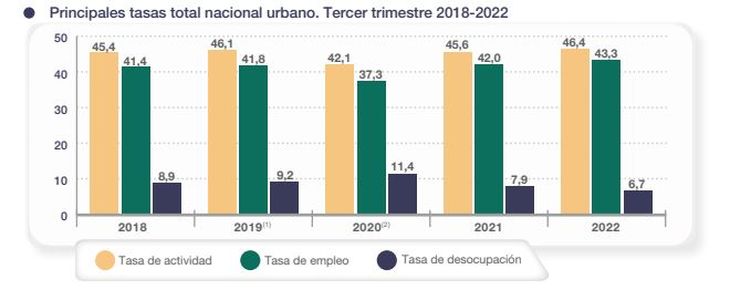Total family income is defined as the sum of the individual income of all the people in the household and includes amounts not attributable to one in particular. In this sense, according to the data measured by INDEC, Chaco registered the lowest average total family income with $101,754, followed by Formosa ($107,820) and La Rioja ($108,430). At the other end, Tierra del Fuego, the Autonomous City of Buenos Aires and Chubut register the highest family income with $247,340, $220,875 and $197,964 respectively.
Capturaaaa.JPG
Other data
Regarding the labor universe, of a total of 42.3 million urban population it can be linked that the employed population is represented by a total of 18.3 million people while the unemployed represent 1.3 million. The most relevant data in this report is related to those who have a job but nevertheless are looking for a second job (in numbers, there are more than 3 million Argentines).
This can be for two reasons: either your income is insufficient to cover your monthly needs or the working conditions are bad. In either case, the problem affects the entire country.
vacancy.JPG

This shows that the demand for work is greater than the supply, which is why there are 4.3 million people in Argentina (adding the employed looking for work and the unemployed) who compete with each other to access a job.
Regarding the results by province, the unemployment rate by geographical area is higher in Buenos Aires (8.7%), Catamarca (7.3%) and Salta (6.6%). When analyzing the rate of employed but seeking a new job, It can be seen that the problem is registered throughout the country with percentages of up to 2 digits, being higher in Tucumán (29.2%), Mendoza, Jujuy and Córdoba with 23%.
Also, the report shows that the underemployed who work less than 35 hours a week and are willing to work more hours are a total of 2.2 million Argentines.
What happens to informality
As it was well known, unemployment fell in Argentina to 6.7% in the third quarter of 2022, this is equivalent to 1,309,000 Argentines.
The indicator was located like this four tenths below the unemployment rate registered in the third quarter of last year, which was 7.1%reported at the end of 2022 by the statistical agency.
This difference is explained because the new report broadens the universe of calculation to include localities with more than two thousand inhabitants, while the other is prepared with data from the Permanent Household Survey (EPH) of 31 agglomerates with more than 500,000. population. However, one of the most important figures is the percentage of informal employment: 1 in 4 Argentines has an informal job and it is in the provinces where precarious employment is reflected, something that is also palpable at the salary level. On average, registered wage earners received $102,247 and unregistered $58,030, a gap of more than 50%.
Source: Ambito




